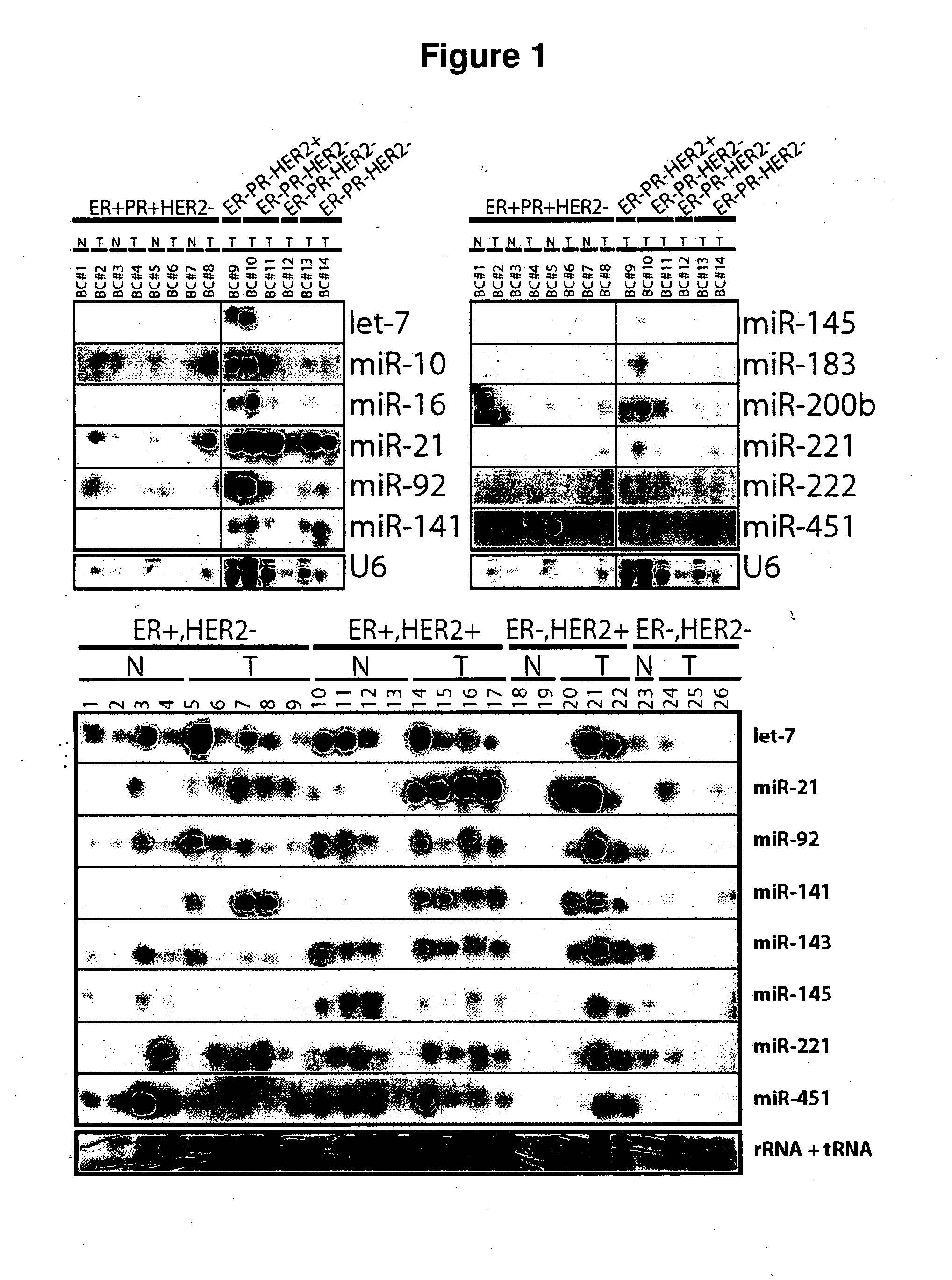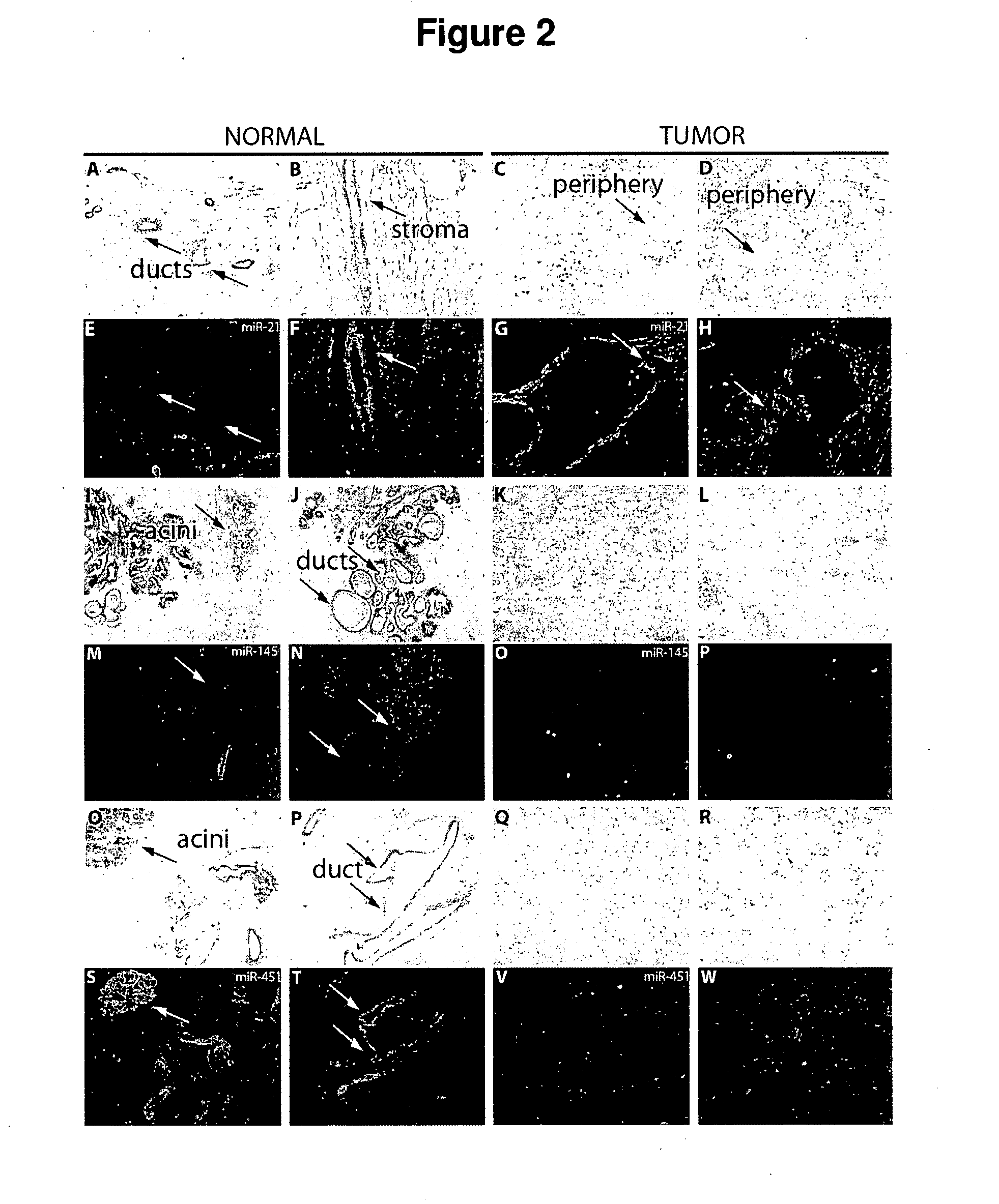MicroRNA biomarkers for human breast and lung cancer
a microrna biomarker and human breast cancer technology, applied in the direction of genetic material ingredients, instruments, drug compositions, etc., can solve the problems of fatal disease, insufficient understanding, incomplete or misleading clinical information,
- Summary
- Abstract
- Description
- Claims
- Application Information
AI Technical Summary
Benefits of technology
Problems solved by technology
Method used
Image
Examples
example 1
[0184] Identification of novel, differentially expressed miRNAs in breast tumours
TABLE IThe 10 breast cancer cases used to identify novel, differentially expressedmiRNAs in example 1. Four of these cases, all which are ER+ (i.e. BC# 2, 4, 6, 8),have a matching normal tissue section. Most of these tumours are infiltrating ductalcarcinomas, of high grade. These tumours represent a range of stages due totumour size from 1.8 to 7.2 cm and node status.Brief nameSubtypeCommentsTypeGradeSizeNodesBC#1ER+ / PR+ / HER2−NormalN / AN / AN / AN / ABC#2ER+ / PR+ / HER2−ER+ TumorIDCaLG1.8 cm1 of 4BC#3ER+ / PR+ / HER2−NormalN / AN / AN / AN / ABC#4ER+ / PR+ / HER2−ER+ TumorIDCaHG2.0 cm1 of 1BC#5ER+ / PR+ / HER2−NormalN / AN / AN / AN / ABC#6ER+ / PR+ / HER2−ER+ TumorIDCaHG7.0 cm3 of 7BC#7ER+ / PR+ / HER2−NormalN / AN / AN / AN / ABC#8ER+ / PR+ / HER2−ER+ TumorIDCaHG4.5 cmNot doneBC#9ER− / PR− / HER2+ER− TumorIDCaHG2.1 cm1 of 1BC#10ER− / PR− / HER2−ER− TumorMet CaHG2.9 cm0 of 4BC#11ER− / PR− / HER2−ER− TumorIDCaHG2.8 cm0 of 7BC#12ER− / PR− / HER2+ER− TumorIDCaHG3.3 cm19 of 22...
example 2
[0195] Determination of spatial distribution of selected miRNAs in formalin-fixed paraffin-embedded tumour sections by LNA in situ hybridization.
TABLE VIIn situ detection of four miRNAs in tumour sections of 9 cases of breast cancer. All these FFPE tumour sections were accompanied with a matchingsection from the same patient. This table summarizes results of the experiments looking at 5-10 random of each normal and tumour section fields underthe epifluorescence microscope. Signal intensity was visually quantified from no expression (0) to high expression (3) in stroma and epithelial structures(lobules and milk ducts) for normal section and only in tumour mass for tumour section.
Definitions
IG = intermedoate grade
HG = high grade
EpiStruct = Epithelial structures (ducts and lobules)
[0196] 5′ FITC-labeled LNA probes complementary for hsa-miR-21, hsa-miR-141, hsa-miR-145 and hsa-miR451 were purchased from Exiqon, Denmark and used in this in situ hybridization experiments. In situs w...
example 3
The Novel microRNA Biomarker Sequences
[0200] 1. The following miRNAs are downregulated in breast tumours compared to normal breast biopsies both analyzing whole samples by Northern and LNA microarray technique and analyzing spatial distribution of miRNAs within epithelial structures of breast tissue by in situ hybridization technique:
A) hsa-miR-451;5′-aaaccguuaccauuacugaguuu-3′(SEQ ID NO: 1)B) hsa-miR-143;5′-ugagaugaagcacuguagcuca-3′(SEQ ID NO: 2)C) hsa-miR-145;5′-guccaguuuucccaggaaucccuu-3′(SEQ ID NO: 3)
[0201] 2. The following miRNAs are upregulated in specific subtypes of breast tumours compared to normal breast biopsies and in some instance additional evidence of this fact was obtained by in situ hybridization technique:
A) hsa-miR-141;5′-uaacacugucugguaaagaugg-3′(SEQ ID NO: 4)B) hsa-miR-200b;5′-uaauacugccugguaaugaugac-3′(SEQ ID NO: 5)C) hsa-miR-200c;5′-uaauacugccggguaaugaugg-3′(SEQ ID NO: 6)D) hsa-miR-221;5′-agcuacauugucugcuggguuuc-3′(SEQ ID NO: 7)E) hsa-miR-222;5′-agcuacau...
PUM
| Property | Measurement | Unit |
|---|---|---|
| Fraction | aaaaa | aaaaa |
| Time | aaaaa | aaaaa |
| Time | aaaaa | aaaaa |
Abstract
Description
Claims
Application Information
 Login to View More
Login to View More - R&D
- Intellectual Property
- Life Sciences
- Materials
- Tech Scout
- Unparalleled Data Quality
- Higher Quality Content
- 60% Fewer Hallucinations
Browse by: Latest US Patents, China's latest patents, Technical Efficacy Thesaurus, Application Domain, Technology Topic, Popular Technical Reports.
© 2025 PatSnap. All rights reserved.Legal|Privacy policy|Modern Slavery Act Transparency Statement|Sitemap|About US| Contact US: help@patsnap.com



